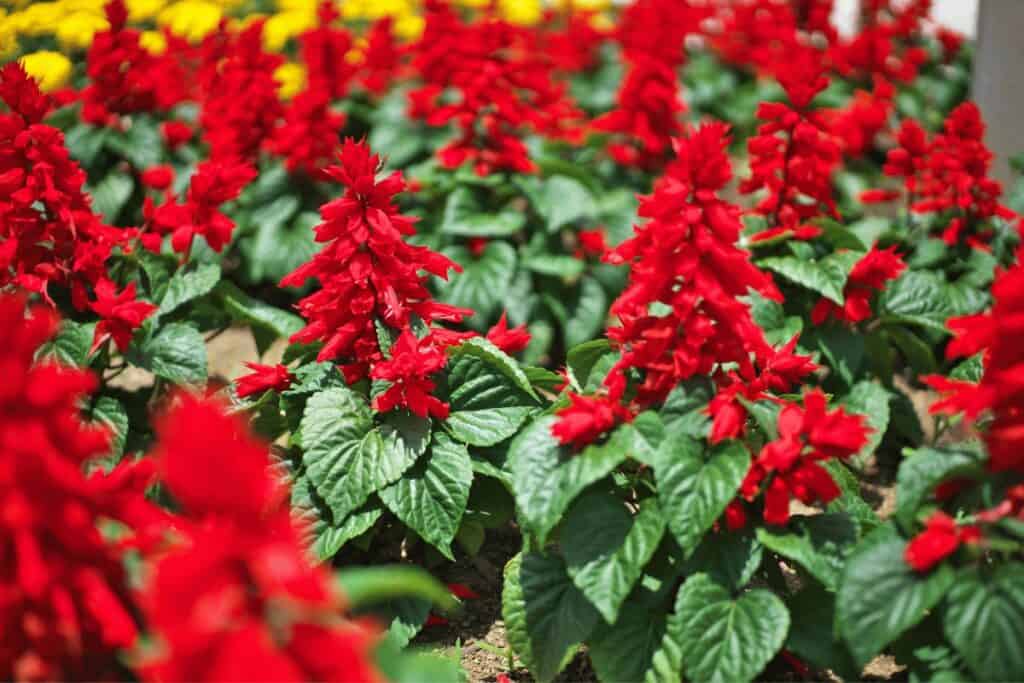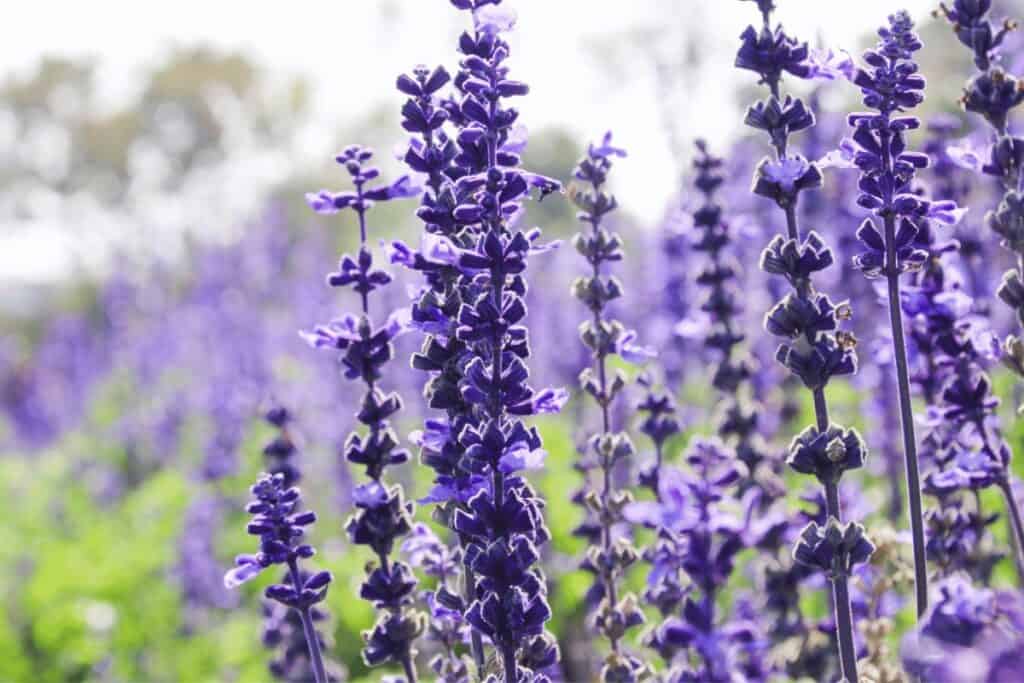Salvias are a group of plants that come in many different species and varieties, and they are known for their vibrant colors and the attractiveness they add to gardens. However, there is a lot of confusion surrounding the spreading habits of these plants, with some sources claiming that they are invasive, while others suggest that they do not spread readily at all.
In the article, Are Salvias Invasive? Understanding Their Spreading Habits. We will take a closer look at the different types of Salvias and their spreading habits to help you better understand whether they can become invasive in your garden.
What Are Salvias?

Before we delve into the topic of Salvias’ spreading habits, it’s important to define what these plants are. Salvias are a genus of plants that belong to the mint family, Lamiaceae. There are over 900 species of Salvias worldwide, with many different colors, shapes, and sizes. Some of the most popular Salvias include Salvia lyrata, Salvia officinalis, and Salvia divinorum, among others.
Types of Salvias and Are Salvias Invasive
Salvias can be divided into two main categories: native and non-native. Native Salvias are those that are naturally found in a particular region and have evolved over time to adapt to the local environment. Non-native Salvias, on the other hand, are those that have been introduced to a region and may not have any natural predators or competitors.
Understanding Their Spreading Habits of Salvia
Salvia is a genus of plants that contains over 900 species of herbs and shrubs, most of which are native to the Northern Hemisphere. While salvia is not normally considered an invasive species, certain species can become invasive in certain climates.
In the United States, salvia species such as Salvia reflexa, Salvia lyrata, and Salvia coccinea can become invasive in some regions [1]. However, salvias are generally not considered invasive as they do not spread very readily for the most part and will remain in the location where they are planted [2]. While some species can grow rapidly and reach up to 5-6 feet in a season, others are low-growing and can be used along flower bed edges.
Depending on the species, salvias can range in width from 12 inches to 4 feet [3]. Therefore, the extent of the spread is unlikely to cause significant problems in your garden. It is important to check the specific species of salvia before planting them to ensure that they are suitable for your region and will not become invasive.

Invasive Salvias
There are several Salvias that are considered invasive due to their aggressive spreading habits. These include:
Salvia Lyrata
Salvia lyrata, also known as lyre-leaved sage, is a native plant to the southeastern United States. This plant can grow up to two feet tall and has purple-blue flowers. It is considered invasive because it can quickly spread and dominate native plant communities, reducing biodiversity. [1]
Salvia Arenaria
Salvia Arenaria, also known as sand sage, is a native plant to the western United States. This plant can grow up to four feet tall and has yellow flowers. It is considered invasive because it can displace native plants and alter ecosystem processes. [1]
Salvia Pratensis
Salvia pratensis, also known as meadow sage, is a native plant to Europe. This plant can grow up to three feet tall and has blue-violet flowers. It is considered invasive because it can form dense stands and outcompete native plants. [1]
Salvia Divinorum
Salvia divinorum, also known as diviner’s sage, is a non-native plant from Mexico. This plant can grow up to six feet tall and has purple flowers. It is considered invasive because it can escape cultivation and establish itself in natural areas, potentially disrupting local ecosystems. [1]
Salvia Miltiorrhiza
Salvia miltiorrhiza, also known as red sage or danshen, is a non-native plant from China. This plant can grow up to three feet tall and has red flowers. It is considered invasive because it can form dense stands and displace native plants in wetland habitats.
What Are Invasive Salvias
If you are a gardener or plant enthusiast, you may have heard of Salvias. Salvias are members of the mint family, and they are often grown for their ornamental value and medicinal properties [2].
While many Salvia species are non-invasive, some varieties have a reputation for spreading aggressively and can quickly take over a garden if left unchecked. Here’s what you need to know about invasive Salvias.
According to [1], there are several Salvia species that are considered invasive, including Salvia lyrata, Salvia arenaria, Salvia officinalis, Salvia pratensis, Salvia divinorum, and Salvia miltiorrhiza. These species can spread aggressively and take over a garden if left unchecked.
However, not all Salvias are invasive. In fact, Salvias are generally considered to be non-invasive [3]. While there are some species that can be mildly invasive in certain regions of the country, they are not typically considered a significant problem.
For example, Salvia Ethiopia is considered invasive in parts of Colorado, Washington, Oregon, Arizona, California, Idaho, and Nevada [3].
It’s worth noting that some Salvia species are simply more aggressive than others. For example, Salvia lyrata and Salvia arenaria are known to spread quickly and can be difficult to control [1]. As with any plant, it’s important to research the specific species before adding it to your garden to ensure that it is a good fit for your needs.
In conclusion, while many Salvias are non-invasive and can be a beautiful addition to your garden, there are some varieties that have a reputation for spreading aggressively. It’s important to research the specific species before adding it to your garden and to keep a close eye on any Salvias that have a reputation for spreading quickly. With proper care and maintenance, Salvias can be a beautiful and low-maintenance addition to any garden.
Types of Salvias Native
Salvia is a genus of plants that contains about 960 species of herbaceous and woody plants of the mint family (Lamiaceae) [1]. Salvias are found all over the world and are especially diverse in Central America and the Mediterranean region. Some of the common names for salvias include sage and meadow sage.
There are many species and cultivars of salvias, and they vary in their leaf shape, texture, and flower color. Some of the most popular salvias include Salvia officinalis, commonly known as culinary sage, which is used for seasoning in many cuisines, and Salvia divinorum, which has psychoactive properties and is used for spiritual purposes.
Native species of salvias are those that are naturally found in a particular region without human intervention. For example, in North America, there are several native species of salvias, including Salvia coccinea, Salvia texana, Salvia azurea, and Salvia greggii. These native species are adapted to the climate and soil conditions of their region and are an important part of the local ecosystem.
Salvia coccinea, also known as scarlet sage or tropical sage, is a popular native species that is commonly found in the southeastern United States. It has bright red tubular flowers that attract hummingbirds and butterflies. Salvia greggii, also known as autumn sage, is another popular native species that is found in the southwestern United States and northern Mexico. It has small, fragrant flowers in shades of pink, red, and purple.
In summary, there are many types of salvias that are native to different regions around the world. These native species are adapted to the local climate and soil conditions and are an important part of the local ecosystem. Some popular native species in North America include Salvia coccinea and Salvia greggii.
Types of Salvias Non-Native
Salvias, also known as sages, are a popular garden plant due to their extended flowering period and ability to thrive in hot, dry conditions. While many salvias are native to various parts of the world, there are also numerous non-native species that have been introduced to new environments. Here are some common non-native types of salvias:
Pineapple sage (Salvia elegans):
This species, native to Mexico and Guatemala, is known for its pineapple-scented foliage and bright red flowers. It is a popular garden plant in many parts of the world due to its ornamental value and culinary uses.
Russian sage (Perovskia atriplicifolia):
Despite its name, this plant is actually a member of the mint family and not a true sage. Native to central Asia, it is valued for its silvery foliage and delicate blue-purple flowers.
Mexican bush sage (Salvia leucantha):
This species, native to Mexico and Central America, is prized for its long blooming period and showy, velvety purple flowers. It is often used as an ornamental plant in gardens and landscaping.
Autumn sage (Salvia greggii):
This species, native to Texas and Mexico, is a popular garden plant due to its long blooming period and tolerance for hot, dry conditions. It has small, brightly colored flowers that range from red and pink to white and lavender.
Chinese sage (Salvia chinensis):
This species, native to China and Korea, is often grown for its ornamental value, with bright blue-purple flowers that bloom in late summer.
While these non-native salvias may offer unique ornamental value to gardens, it is important to be mindful of their potential to become invasive in certain environments. As with any plant, it is important to research the specific species and its growing requirements before introducing it to a new environment.
FAQs:
Are all Salvias invasive?
No, not all Salvias are invasive. While some species are known to spread aggressively, many Salvias are non-invasive and can be a beautiful addition to your garden.
Which Salvias are considered invasive?
According to [1], Salvia lyrata, Salvia arenaria, Salvia officinalis, Salvia pratensis, Salvia divinorum, and Salvia miltiorrhiza are considered invasive.
Is Salvia divinorum invasive?
Yes, Salvia divinorum is considered invasive [1].
Can I still plant Salvias if I’m worried about them being invasive?
Yes, you can still plant Salvias in your garden. It’s important to research the specific species before adding it to your garden to ensure that it is a good fit for your needs.
How can I control invasive Salvias in my garden?
If you have invasive S
If you have invasive Salvias in your garden, it’s important to take action to control them before they take over. One effective method is to pull them up by the roots as soon as you notice them. You can also try using a herbicide specifically designed for the type of Salvia you are dealing with. Be sure to follow the instructions carefully and use caution when using any herbicide in your garden.
Conclusion
In conclusion, salvias are a diverse group of plants that offer an incredible range of color, fragrance, and texture to any garden. While some species can become invasive in certain climates, most salvias do not spread readily and are unlikely to cause significant problems in a garden [1].
Understanding their spreading habits is crucial in determining which species to grow and how to manage them. Salvias range in width from 12 inches to 4 feet and can grow rapidly, reaching up to 5 to 6 feet within a season [3].
When selecting salvias for your garden, it is important to research the specific species you are interested in and consider its potential for invasive behavior, growth habit, and other characteristics. Proper care, such as pruning and deadheading, can help manage their spread and ensure that they remain a beautiful addition to any garden.




